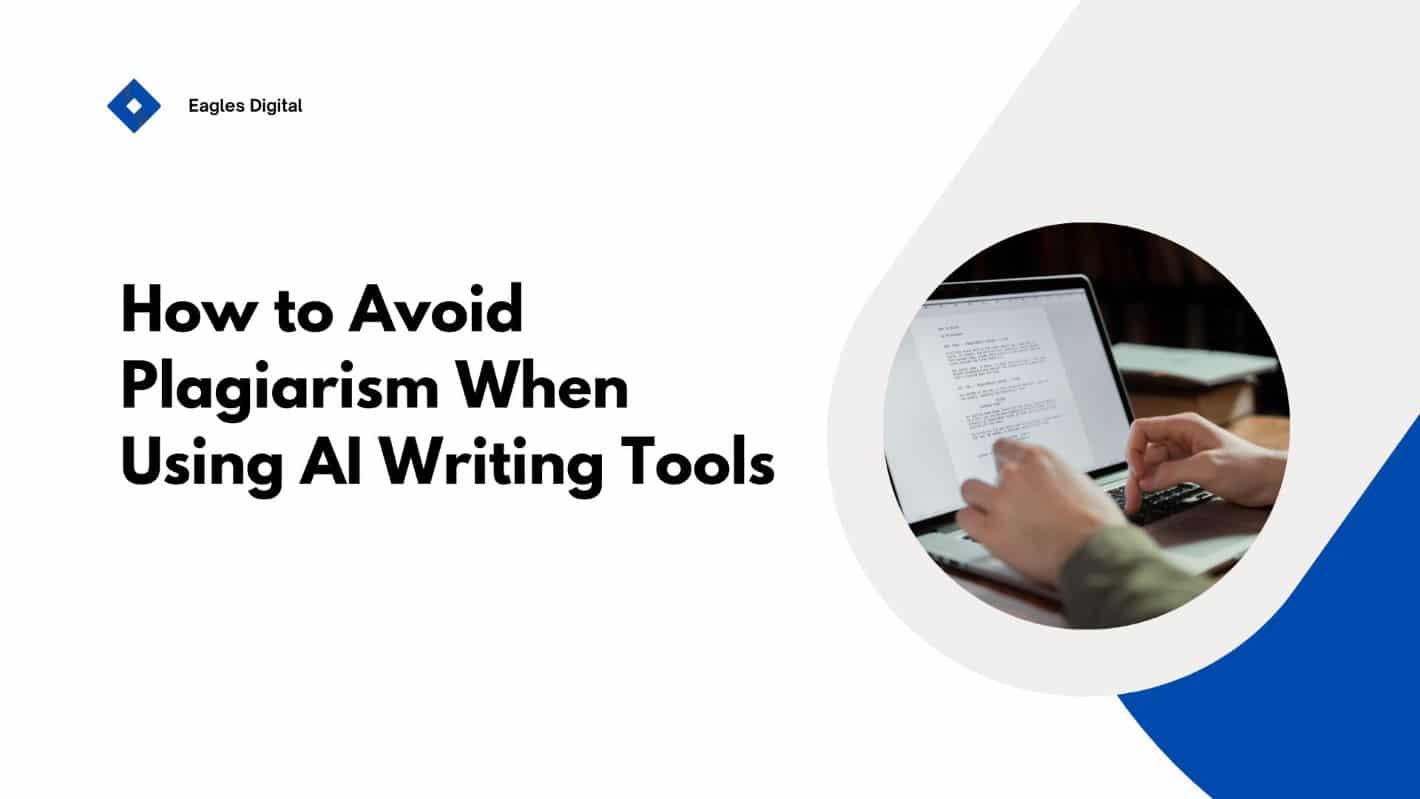How to Avoid Plagiarism When Using AI Writing Tools

Avoiding plagiarism when using AI writing tools is essential to maintaining originality and protecting your credibility as a content creator.
Plagiarism can occur unintentionally if the AI tool generates content that closely resembles existing material. If left unchecked, this could lead to serious consequences like loss of trust or even legal issues.
Implementing best practices and thoroughly reviewing AI-generated content for originality is crucial to ensuring your work remains unique.
At Eagles Digital, we prioritize ethical content creation and take steps to verify the uniqueness of everything we publish. Many tips we recommend to avoid plagiarism with AI tools are strategies we’ve successfully applied ourselves.
In this article, we’ll share actionable steps to help you prevent plagiarism when leveraging AI writing tools.
Let’s dive right in.
What is plagiarism?
Plagiarism is the act of using someone else’s work without proper attribution, claiming their ideas or words as your own.
This can happen in various forms: copying text word-for-word, paraphrasing without attribution, or even reusing your own previous work (known as self-plagiarism) inappropriately.
As students or content creators, you need to understand what constitutes plagiarism to maintain integrity in your work.
The good news is that there are plenty of plagiarism detection software that can help you ensure your work is original. These tools provide everything you need to verify your content’s authenticity. Some even allow you to run a basic check for free.
If you’re a student, researcher, or content creator, it’s essential to understand the best tools and practices for avoiding plagiarism.
You’re responsible for making sure what you create reflects your ideas and credits others when necessary. Following these practices not only keeps your work professional but also builds trust with your audience.
How to Avoid Plagiarism When Using AI Writing Tools
Here are the steps to follow to avoid plagiarism when using generative AI tools
1. Choose Reliable AI Writing Tools
Choosing the right AI writing tool forms the foundation of creating original content.
AI writing assistants vary widely in their ability to generate original content. A reputable platform can help you produce more distinctive and impactful results.
You should look for tools that prioritize original content generation and offer features specifically designed to maintain content authenticity.
Premium AI writing tools often incorporate built-in plagiarism detection and originality enhancement features. Tools like Jasper AI, Copy.ai, and ChatGPT have established themselves as reliable options that focus on generating unique content rather than recycling existing material.
When selecting your tool, prioritize those with transparent AI models and clear policies regarding content originality.
Trust me, investing in a quality AI writing tool can save you considerable time and effort in the long run. This approach will definitely reduce the need for extensive rewrites and plagiarism checks.
If you’re not sure which AI writing tool to use, check out our ultimate guide to choosing the best AI writing tool.
2. Understand the Source of AI-Generated Content
Understanding how AI tools generate content is crucial for avoiding unintentional plagiarism.
AI language models are trained on massive datasets of text, which means they can sometimes replicate phrases from their training data, potentially leading to unintentional plagiarism. This knowledge helps you recognize when content might need additional modification to ensure originality.
It’s a good idea to familiarize yourself with your chosen AI tool’s documentation and guidelines.
Most reputable AI writing platforms provide information about their training methods and best practices for generating original content. This information can help you craft better prompts and recognize when output might need more substantial revision.
AI processes information differently than humans. While it can create coherent text, it lacks the human ability to generate original ideas. Your role is to transform this output into original content through your expertise and perspective.
3. Edit and Customize AI-Generated Content
The most critical step in avoiding plagiarism is thoroughly editing and customizing AI-generated content.
If you want your content to stand out, you must produce content that is authentic and unique.
Always treat AI output as a starting point or draft that requires thorough modification.
By doing this, you ensure that your final content reflects your unique voice and expertise.
Start by reviewing the AI-generated content for common phrases or generic statements that might appear in other sources.
Replace these with specific examples from your experience or industry knowledge. You can also add relevant case studies, current statistics, and original insights that make the content uniquely yours.
Here is my recommendation for implementing a structured editing process:
- First, revise the content’s structure and flow to match your style.
- Then, add your personal insights, examples, and industry-specific knowledge.
- Finally, polish the language to ensure it aligns with your brand voice and professional standards.
4. Use Plagiarism Detection Software
Even after careful editing, running your content through plagiarism detection software provides an additional layer of security. This step helps identify any unintended similarities with existing content that may have gone unnoticed during editing.
Use modern plagiarism checkers like Copyscape, Grammarly Premium, and Turnitin to detect subtle similarities with existing online content. Make this check a mandatory part of your content creation workflow, especially for important or professional pieces.
As a full-time content creator, I always consider using multiple plagiarism detection tools for crucial content, as different tools may catch different types of similarities. This comprehensive approach helps me ensure my content is as original as possible.
5. Cite Your Sources Properly
Citing your sources is crucial when using AI tools for research or summaries. If your AI-generated content includes facts, statistics, or specific claims, double-check their accuracy and cite the original sources rather than the AI tool.
Develop a systematic approach to tracking sources during your content creation process. You can keep detailed notes about where information comes from, and implement a consistent citation style appropriate for your content type and industry.
It’s important to be transparent about AI tool usage, especially when required by organizations or publications with specific guidelines for AI-assisted content.
6. Avoid Over-Reliance on AI Tools
While AI writing tools are powerful aids, they should complement rather than replace your expertise and creativity.
Establishing a balanced approach where AI assists your writing process without dominating it helps maintain content originality.
Use AI writing tools strategically for specific purposes – perhaps for generating initial ideas, overcoming writer’s block, or suggesting alternative phrasings. But always ensure your unique insights, experience, and voice shine through in the final content.
AI assists, but your expertise drives the best results.
FAQs About Avoiding Plagiarism with AI Writing Tools
What is the best plagiarism checker for AI-generated content?
Grammarly and Turnitin offer some of the best options for detecting plagiarism in your AI-generated content. With features like highlighting duplicate content and suggesting corrections, these tools help you ensure your writing is authentic.
Can AI writing tools create completely original content?
AI writing tools are powerful assistants, but they can’t replace your creativity and judgment. These tools pull from vast datasets to craft their outputs, so it’s crucial to review and personalize the content to make it truly original.
Conclusion
Avoiding plagiarism when using AI writing tools is more important than ever as content creation evolves.
The tips and strategies shared above aren’t just theoretical—they’re practical, effective ways to ensure your writing stays original and credible.
From generating ideas with AI to carefully checking for originality, each step helps you create content that is both authentic and valuable to your audience. These practices will help you use AI writing tools responsibly and maintain academic integrity.


